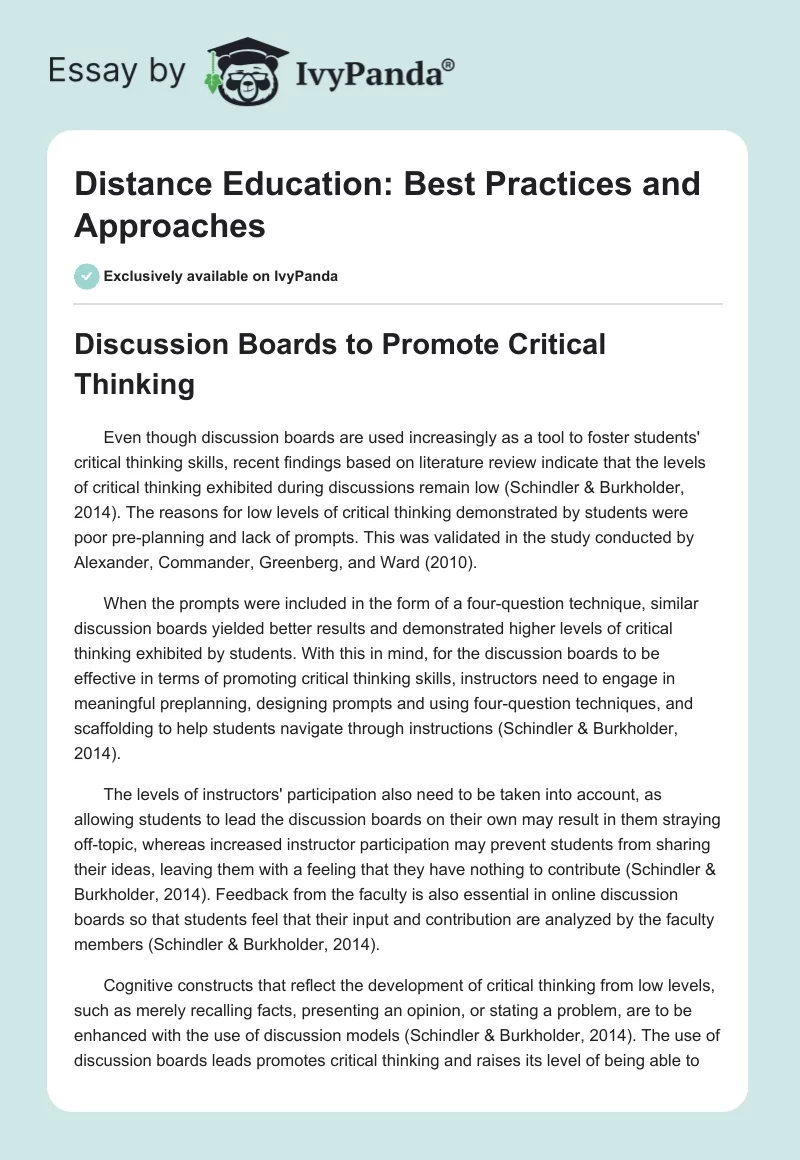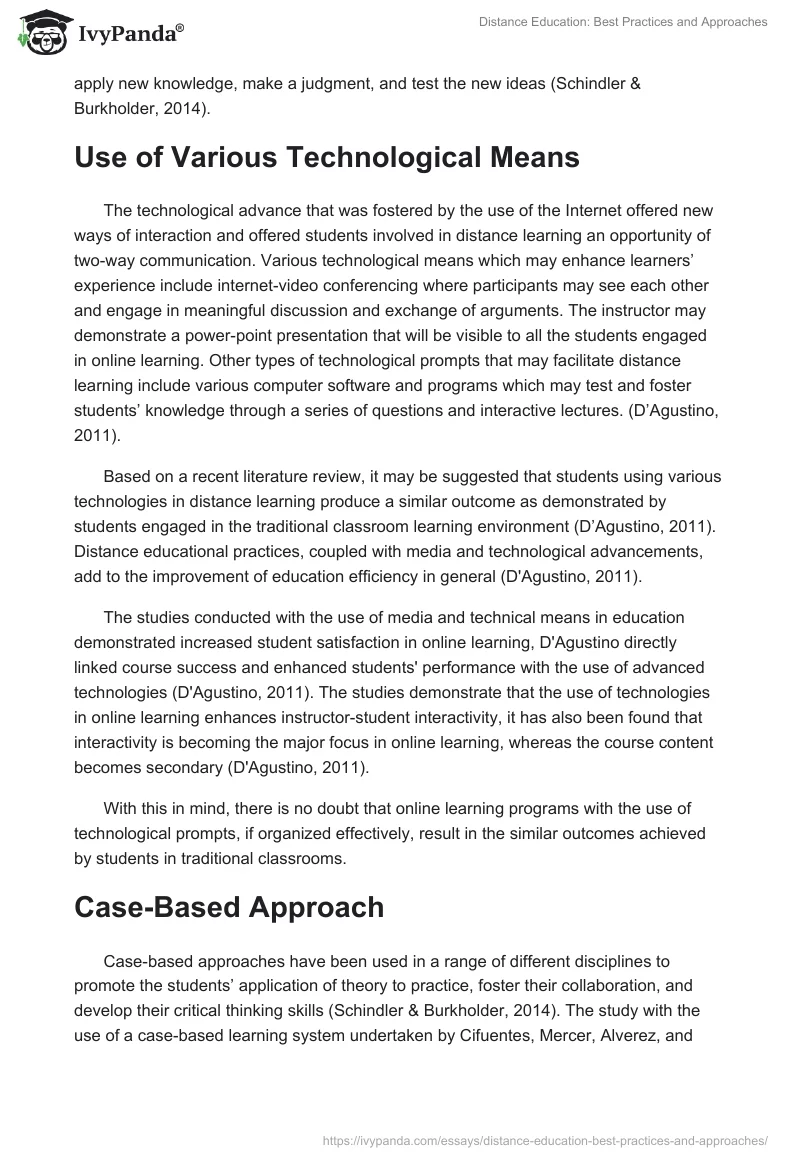Discussion Boards to Promote Critical Thinking
Even though discussion boards are used increasingly as a tool to foster students’ critical thinking skills, recent findings based on literature review indicate that the levels of critical thinking exhibited during discussions remain low (Schindler & Burkholder, 2014). The reasons for low levels of critical thinking demonstrated by students were poor pre-planning and lack of prompts. This was validated in the study conducted by Alexander, Commander, Greenberg, and Ward (2010).
When the prompts were included in the form of a four-question technique, similar discussion boards yielded better results and demonstrated higher levels of critical thinking exhibited by students. With this in mind, for the discussion boards to be effective in terms of promoting critical thinking skills, instructors need to engage in meaningful preplanning, designing prompts and using four-question techniques, and scaffolding to help students navigate through instructions (Schindler & Burkholder, 2014).
The levels of instructors’ participation also need to be taken into account, as allowing students to lead the discussion boards on their own may result in them straying off-topic, whereas increased instructor participation may prevent students from sharing their ideas, leaving them with a feeling that they have nothing to contribute (Schindler & Burkholder, 2014). Feedback from the faculty is also essential in online discussion boards so that students feel that their input and contribution are analyzed by the faculty members (Schindler & Burkholder, 2014).
Cognitive constructs that reflect the development of critical thinking from low levels, such as merely recalling facts, presenting an opinion, or stating a problem, are to be enhanced with the use of discussion models (Schindler & Burkholder, 2014). The use of discussion boards leads promotes critical thinking and raises its level of being able to apply new knowledge, make a judgment, and test the new ideas (Schindler & Burkholder, 2014).
Use of Various Technological Means
The technological advance that was fostered by the use of the Internet offered new ways of interaction and offered students involved in distance learning an opportunity of two-way communication. Various technological means which may enhance learners’ experience include internet-video conferencing where participants may see each other and engage in meaningful discussion and exchange of arguments. The instructor may demonstrate a power-point presentation that will be visible to all the students engaged in online learning. Other types of technological prompts that may facilitate distance learning include various computer software and programs which may test and foster students’ knowledge through a series of questions and interactive lectures. (D’Agustino, 2011).
Based on a recent literature review, it may be suggested that students using various technologies in distance learning produce a similar outcome as demonstrated by students engaged in the traditional classroom learning environment (D’Agustino, 2011). Distance educational practices, coupled with media and technological advancements, add to the improvement of education efficiency in general (D’Agustino, 2011).
The studies conducted with the use of media and technical means in education demonstrated increased student satisfaction in online learning, D’Agustino directly linked course success and enhanced students’ performance with the use of advanced technologies (D’Agustino, 2011). The studies demonstrate that the use of technologies in online learning enhances instructor-student interactivity, it has also been found that interactivity is becoming the major focus in online learning, whereas the course content becomes secondary (D’Agustino, 2011).
With this in mind, there is no doubt that online learning programs with the use of technological prompts, if organized effectively, result in the similar outcomes achieved by students in traditional classrooms.
Case-Based Approach
Case-based approaches have been used in a range of different disciplines to promote the students’ application of theory to practice, foster their collaboration, and develop their critical thinking skills (Schindler & Burkholder, 2014). The study with the use of a case-based learning system undertaken by Cifuentes, Mercer, Alverez, and Bettati in 2010 demonstrated that students could remotely participate in the learning process without the need to be physically present in the classroom.
The studies demonstrated that the use of the case-based approach allowed students to put the acquired theoretical skills into practice, more so, students who underwent the case-based approach were found to be better in job performance and developed better practical skills (Cifuentes et al., 2010). The studies also revealed that students who did not use the case-based approach demonstrated a lack of practical skills (Cifuentes et al., 2010). The case-based learning environment has been proved to be capable of addressing social problems that are relevant and pressing (Cifuentes et al., 2010).
Preliminary findings demonstrate that the use of a case-based approach allows students to engage in a meaningful learning experience that prepares and equips them for future work. Another study undertaken in Korea demonstrated that the students who had undertaken the case-based approach reported higher satisfaction with the learning course, and more importantly, enhanced their decision-making skills. The study revealed that students who were taught on the basis of the traditional approach reported lower satisfaction scores and did not enhance their decision-making skills (Park & Park, 2015).
Balance between Course Work and Discussions
Discussions, although a critical component of learning, may easily consume half of the students’ course load if not balanced properly (Goldman, 2011). With this in mind, discussion sessions need to be implemented with care so that the overall students’ workload is not compromised. It is difficult for instructors to properly balance the discussion and course load as demanding discussions are likely to discourage students whereas lack of discussion practice will result in a failure to deliver the course objectives (Goldman, 2011).
To achieve a win-win balance between discussion and workload, Goldman (2011) devised and proposed a Discussion Guideline document which provided guidance in arranging and managing discussions, Goldman maintains that the document contains the synthesis of the previously suggested discussion rules as well as a set of suggested best practices which aid instructors in achieving the right amount of balance in discussion sessions (Goldman, 2011).
Aside from achieving the optimal balance, the Discussion Guideline document addresses issues such as achieving course program consistency, meaning that the instructions and the guidelines need to be uniformly employed by all of the teaching staff and students to avoid disparities (Goldman, 2011).
Achieving the right balance between course work and instruction has been found to encourage better learner attitude and expression style, students have also demonstrated increased tolerance and respect of all ideas with the depersonalization of debates (Goldman, 2011). The practice of balancing course work and discussions led to students’ encouragement in sharing their experience, conducting research and responding to each other’s questions. Goldman (2011) found that balance between discussion and course-work stimulated students’ critical thinking with the use of collaboration exercises. Furthermore, properly balanced instructions develop social strategies, facilitate and control the level of instructor engagement (Goldman, 2011).
Reference List
Alexander, M. E., Commander, N., Greenberg, D., & Ward, T. (2010). Using the four- questions technique to enhance critical thinking in online discussions. Journal of online learning and teaching, 6(2), 409-415. Web.
Cifuentes, L., Mercer, R., Alverez, O., & Bettati, R. (2010). An Architecture for Case- based Learning. TechTrends, 54(6), 44-50. Web.
D’Agustino, S. (2012). Toward a course conversion model for distance learning: a review of best practices. Journal of international education in business, 5(2), 145-162. Web.
Goldman, Z. (2011). Balancing Quality and Workload in Asynchronous Online Discussions: A Win-Win Approach for Students and Instructors. Journal of online learning and teaching, 7(2), 313-323. Web.
Park, E. J., & Park, M. (2015). Effectiveness of a Case-Based Computer Program on Students’ Ethical Decision Making. Journal of nursing education, 54(11), 633-640. Web.
Schindler, L. A., & Burkholder, G. J. (2014). Instructional Design and Facilitation Approaches that Promote Critical Thinking in Asynchronous Online Discussions: A Review of the Literature. Higher learning research communications, 4(4), 11-29. Web.


